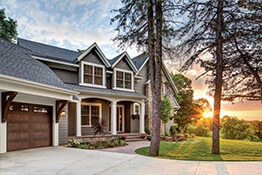Plastic siding, also known as vinyl siding is found on the exterior of many residential and commercial buildings today. A crucial part of architecture and structure defense, it's made up of a type of manmade plastic resin known as Polyvinyl Chloride (PVC). This versatile exterior decorating and protective material has gained immense popularity due to its various benefits, from reliable shielding against different weather conditions to affordable cost and low-maintenance requirements. In this article, we will delve into the depths of plastic siding, exploring what it is, its types, how it works, its maintenance, and much more.
The Different Types of Plastic Siding
As is common with most products, not all plastic sidings are created equal. There are different types of plastic siding on the market, and each one comes with its unique characteristics. The three main types are:
-
Standard (hollow back) Vinyl Siding: This is the most commonly used type for residential homes. It features a flat and lightweight profile.
-
Foam-backed Vinyl Siding: This type has insulating foam attached to the back, improving energy efficiency and reducing noise transmission.
-
Insulated Siding: It is filled with expandable polystyrene foam (EPS) and is designed to reduce energy loss through the exterior walls of the home.
The Durability of Plastic Siding
One of the reasons people opt for plastic siding is its durability. It is designed to resist various harmful factors that other sidings succumb to. These include insects, rotting, and different extreme weather conditions. Under optimal conditions, plastic siding is said to last up to 60 years!
The Installation Process of Plastic Siding
Installation of plastic siding on your home or commercial building can indeed be a DIY project, but it requires a specific set of tools and quite a bit of technical knowledge. Therefore, outsourcing this task to professionals is often more time-efficient and results in a better quality finish.
Cost of Plastic (vinyl) Siding Installation
The cost of installing plastic siding is much less than other materials such as wood or fiber cement. The total price involves the cost of the material, labor, and other additional supplies used in the installation process. Prior quotation from professional installers can help in budget planning and avoids underestimation or overestimation.
Maintaining Plastic Siding
Part of what makes plastic siding a popular choice among homeowners and commercial property owners is its low-maintenance requirement. It is designed to be a long-term solution to siding, needing little to no routine maintenance.
-
Cleaning: A gentle annual cleaning with a power washer can help maintain its vibrant look and prevent mold and mildew.
-
Inspection: Regular inspection for cracks and loose panels is highly recommended to address potential issues timely.
The Environmental Impact of Plastic Siding
Plastic siding has a lesser environmental impact compared to other siding materials. The production of vinyl siding uses less energy compared to other materials. Moreover, its long lifespan and recyclability minimize waste and energy associated with production and disposal.
Reduce, Reuse, Recycle
At the end of its service life, plastic siding doesn’t have to wind up in a landfill. Many manufacturers now have recycling programs in place for their plastic siding products. Moreover, because of its durability, it can often be reused on another building.
Plastic siding remains a top choice for many homeowners and commercial property owners across various demographics. Its durability, cost-effectiveness, energy efficiency, appealing aesthetics, and low maintenance contribute to this widespread acclaim. With options to reduce, reuse, and recycle, it also leaves a smaller environmental footprint. While it may not be for everyone, there's no denying the potential benefits it can offer to the right stylistic and practical needs.
Frequently Asked Questions about Plastic Siding
Why should I choose plastic siding for my home?
Plastic siding, also known as vinyl siding, is a highly durable and low maintenance choice for your home exterior. It resists elements such as moisture and extreme weather, inhibiting the growth of mildew and molds. Moreover, it does not need to be painted as the color is infused during manufacturing.
What types of plastic siding are available?
There are several types of plastic siding available in the market today. The most popular is vinyl siding, followed by UPVC (unplasticized polyvinyl chloride) siding and insulated siding. Each type comes with its own set of features and benefits, thus providing you with a wide range of options to match your home style and needs.
How durable is plastic siding?
Plastic siding is quite durable and can last up to 40 years or more, depending on the quality of the material and installation. Unlike wood or metal, plastic siding doesn't rot or corrode. It also withstands severe weather conditions and is resistant to pests.
How do I maintain plastic siding?
One of the greatest advantages of plastic siding is its minimal maintenance needs. Typically, an annual cleaning with a soft brush and mild detergent is enough to keep it looking new. For any stubborn stains, a mixture of vinegar and water is generally effective.
Is plastic siding environmentally friendly?
Plastic siding has become increasingly eco-friendly over the years. The largest manufacturers have made efforts to reduce the environmental impact by recycling production scraps and reducing energy consumption during manufacturing. In addition, because plastic siding lasts longer and requires less maintenance compared to other materials like wood, it can be a more sustainable choice for your home.
Is plastic siding costly?
Plastic siding is generally cost-effective, especially when considering its durability and low maintenance requirements. However, the total cost can vary significantly depending on factors like your location, the complexity of your home's architecture, and whether or not you choose to install it yourself.
How is plastic siding installed?
Plastic siding is usually installed over a layer of house wrap or insulation to create a protective barrier between your home and the elements. Each panel of siding interlocks with the next, creating a virtually seamless exterior. It's recommended to engage a professional contractor for proper installation, though some homeowners do choose to install it themselves.
Can plastic siding withstand extreme weather conditions?
Yes, plastic siding is designed to hold up well under a variety of weather conditions. However, in extreme cold weather, plastic siding can become rigid and more prone to cracking upon impact.
Can I paint plastic siding?
Plastic siding is not typically designed to be painted because the color is integrated into the material during manufacturing. However, if you decide to change your home color scheme down the road, it can be painted using high-quality acrylic latex paint. It’s important to note that darker shades may absorb more heat and can potentially cause the siding to warp.
Pros of Plastic Siding
Economical
Compared to other siding options such as wood, brick and stone, plastic siding, also known as vinyl siding, is relatively more affordable both in terms of material and installation costs. It offers an excellent cost-effective solution for homeowners that wish to improve their house's aesthetic appeal while staying in budget.
Durability and Longevity
-
Plastic siding is known for its extreme resilience. It is resistant to common elements of weather like heat, cold, rain, and snow, making it a reliable choice for a variety of climate conditions.
-
Different from wood, it is not prone to warping, rotting or pest damage which contributes to its long lifespan. With proper care and maintenance, plastic siding can last up to 40 years or longer.
Low Maintenance
One of the main selling points of plastic siding is its low maintenance requirements. Regular cleaning with soap and water usually keeps it in good condition. It does not need to be repainted or stained regularly unlike other siding materials.
Variety of Styles
-
Plastic siding comes in a range of styles, colors, and textures. You can find almost any look you desire, from traditional clapboard to modern horizontal panels.
-
Some plastic siding even mimic the appearance of other materials like wood or stone, offering a cost-effective way to achieve the desired style without the associated expense and maintenance.
Cons of Plastic Siding
Possibility of Warping or Buckling
While plastic siding is generally durable, improper installation can lead to issues such as warping or buckling over time. This can negatively affect the appearance and performance of the siding. It is thus essential to enlist experienced professionals for its installation.
Lower Energy Efficiency
-
Compared to some other siding materials, such as insulated vinyl or fiber cement, plastic siding falls short in terms of energy efficiency. This could mean higher costs for heating or cooling your home.
-
However, homeowners can opt for insulated plastic siding, which offers improved energy efficiency, albeit at a higher cost.
Environmental Concerns
Plastic siding is not the most environmentally-friendly choice, as it is made from nonrenewable petroleum products. While it lasts for a long time which can be positive, when it does reach the end of its lifespan, disposal can be an environmental challenge since it is not biodegradable.
Less Appealing to Some
-
While plastic siding offers a wide range of styles, some people still find the appearance of it less appealing than natural materials. It might not add as much value to your home compared to other siding options, which could be a disadvantage if you plan to sell your house.
-
Moreover, although it replicates the look of other materials, upon closer inspection it becomes evident that it's not the real thing which might be less satisfactory to some homeowners.
Summary
Thanks to its durability, resistance to damaging weather conditions and relatively low cost, plastic siding has become an increasingly popular choice in home building and renovation. It's simple to install, saving on labor costs and time. Plus, plastic siding doesn't require painting or staining, making it a virtually maintenance-free option that remains looking clean and new for years.
Aside from its practical benefits, plastic siding offers a wide range of design flexibility. With a plethora of colors, textures, and styles to choose from, it can complement any architectural design or enhance the aesthetic appeal of any home. Whether you're aiming for a modern, rustic, or traditional look, you can achieve it with plastic siding.
While it's not perfect, the benefits of plastic siding certainly outweigh its potential downsides. Its eco-friendly attribute due to being recyclable is an added advantage for environmentally conscious homeowners. So whether you're constructing a new house or looking to upgrade your existing one, don't overlook plastic siding as an option. It brings together function, design, and sustainability all in one package.
About US Quality Construction
Welcome to US Quality Construction! We're a reputable construction company based in Kansas City, MO thriving on our mission to build excellence. No matter how big or small your construction project might be, our talented team is ready to turn your vision into reality. Known for our unwavering commitment to design precision, quality materials, and exceptional customer service, we've been serving the Kansas City area for many years. Visit our main website here to explore our past projects and get a glimpse of our construction ethos.
Tags: plastic siding, home improvement, exterior renovation,













